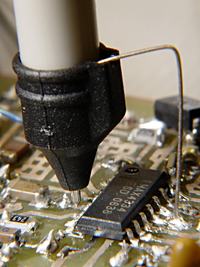grizedale
Advanced Member level 3
Hello,
I recently had to probe a microcontroller pin which was on the same pcb as an smps.......the voltage there was full of noise, and my boss wasn't impressed, so i think i need a scope probe which is just a coaxial cable with a BNC connector at one end, then atthe other end, i will simply solder ground shield and centre conductor to the voltage and ground on the PCB.
But do you know where i can buy:-
~1 metre length of coaxial cable.
a BNC connector.
a tool for stripping the coaxial cable so that i can attach it to the BNC connector.
the tool needed to attach the BNC connector to the coaxial cable.
I cannot find these things anywhere on RS Farnell or digikey
I recently had to probe a microcontroller pin which was on the same pcb as an smps.......the voltage there was full of noise, and my boss wasn't impressed, so i think i need a scope probe which is just a coaxial cable with a BNC connector at one end, then atthe other end, i will simply solder ground shield and centre conductor to the voltage and ground on the PCB.
But do you know where i can buy:-
~1 metre length of coaxial cable.
a BNC connector.
a tool for stripping the coaxial cable so that i can attach it to the BNC connector.
the tool needed to attach the BNC connector to the coaxial cable.
I cannot find these things anywhere on RS Farnell or digikey

